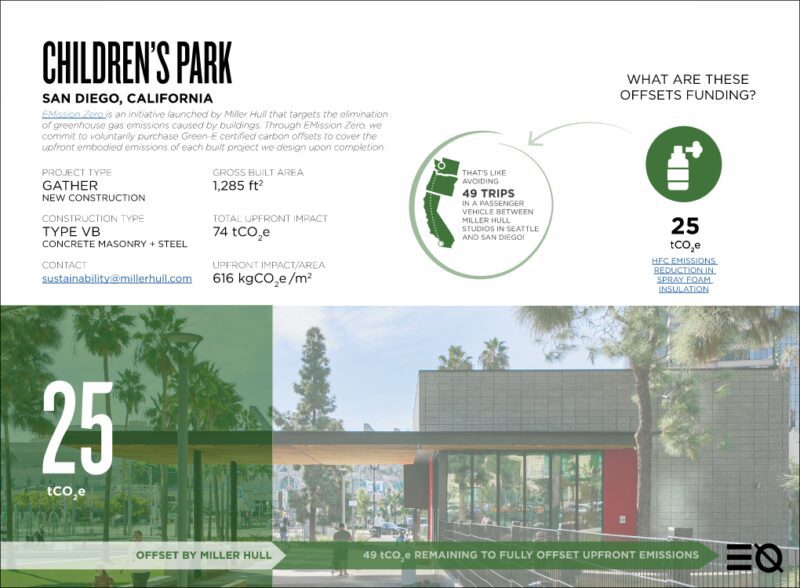Miller Hull
- Portfolio
- Approach
- News
Events
Posted August 18, 2025
- About
- Connect
A community identity is strengthened by a park that is tailor-made for the residents of San Diego.
×- Client City of San Diego
- Size 2,300 SF
- Completion 2023
- EMission Zero Offset 25 tCO2e
San Diego is the quintessential outdoor city. With its temperate climate, proximity to the ocean, and access to over 70 miles of public shoreline, there is ample opportunity for residents to spend time outside and connect with nature.
But for all of San Diego’s outdoor offerings, the city core had always lacked adequate park space, and it wasn’t until 1995 that downtown got its first sizable open green space — a park across the street from the San Diego Convention Center and right along the Martin Luther King Promenade. Designed by renowned landscape architect Peter Walker, the park provided the surrounding community with over 2.6 acres of green space. However, because there were not many people living downtown at the time, the park’s targeted audience members were primarily those who’d be attending the upcoming Republican Convention, to take place right across the street. As such the park had a sculptural emphasis.
As time wore on, the sculptural nature of the park attracted illicit activities within the park due to obstructed sightlines. The park became a place that most of San Diego wanted to avoid. Its densely planted perimeter obscured sight-lines so those outside couldn’t see in, which encouraged illicit activity inside the park boundaries. Additionally, as the homeless population grew, the park became a refuge to an increasing number of unhoused individuals.
The park’s descent into disrepair continued for several years, until the city’s downtown grew to over 37,000 and public green space that functioned as such became absolutely vital. Especially now that It was at this point that we all began imagining what Children’s Park could be if redesigned for the city’s current needs.
What did the city need? A safe and secure public, outdoor area for everyone. A recreational place with ample greenery where all members of the family can enjoy themselves. A renewed community identity reinforced by a central democratic space.
In collaboration with Spurlock Landscape Architects as well as many neighborhood residents, Miller Hull embarked on the expansion and development of the general development plan created by Schmidt Design Group. The re-envisioning of the city’s Children’s Park, creating a structure that provides necessary amenities like bathrooms (and bathroom attendants!) and storage, while creating opportunities for businesses like restaurants and cafes to serve visitors and commercially ground the reinvigorated park. Programmatic spaces like a new playground for children, adult exercise equipment, and a multi-use lawn area add to the inclusiveness and multidisciplinary nature of the park.
Retaining key design elements from the original concept like the civic pond and an array of urban forested spaces, the improved Children’s Park retains the timeless outdoor rooms of its previous design while shifting to serve its new urban constituents.
With the growing population of downtown San Diego, it was clear that the park needed to prioritize the residents to ensure a lively and activated park year-round. The activity centers within the park were specific requests from the surrounding community and are in constant use throughout the day. The retail space brings additional activity along with a means to support some of the ongoing maintenance for the park. While many of the outdoor areas in Downtown have a strong emphasis on tourism, it is clear that this park feels embedded in the community and will continue to foster a strong sense of ownership.
Project Team
Architect: The Miller Hull Partnership, LLP
General Contractor: DMI General Contracting
Landscape Architect: Spurlock Landscape Architects
Structural Engineer: KPFF Consulting Engineers
Mechanical, Electrical & Plumbing Engineer: Randall Lamb Associates, Inc.
Civil Engineer: Chen Ryan Associates
General Development Plan: Schmidt Design Group
Water Feature Design: Aquatic Design Group
Artist: Miki IwasakiEMission Zero Offset
In 2023, Miller Hull offset 417 tCO2e (tons of carbon) as part of our recently launched EMission Zero initiative — a program targeting the elimination of greenhouse gas emissions caused by the built environment.
-
Awards
-
Press
-
San Diego Architecture Foundation
2024 Orchid Award for Landscape Architecture
ASLA San Diego
2024 President’s Award
San Diego Business Journal (SDBJ)
2024 SDBJ Outstanding Architectural Designs
SDAPA Awards / APA CA Chapter Nomination
2024 Urban Design Excellence Award for the San Diego Region
American Public Works Association (APWA) San Diego
2024 Honor Award
AIA San Diego
2024 Honor Award
San Diego Downtown Partnership
2024 Cultural Vitality Award: Create the Future Award
××
